Showing Spotlights 41 - 48 of 252 in category All (newest first):
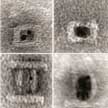 DNA is probably the most programmable biomaterial for creating a wide range of rationally designed and functionally enhanced nanostructures. The sophisticated, programmable, and addressable DNA nanostructures are strong candidates for constructing nanoelectronic devices. The size of DNA molecules is also key: DNA double-helix has a neighboring base pair distance of 0.34 nm and a diameter of 2.1 - 2.6 nm a, and thus DNA complex-based nanoelectronics may break the 5-nm processing limit of commercial silicon-based semiconductors.
DNA is probably the most programmable biomaterial for creating a wide range of rationally designed and functionally enhanced nanostructures. The sophisticated, programmable, and addressable DNA nanostructures are strong candidates for constructing nanoelectronic devices. The size of DNA molecules is also key: DNA double-helix has a neighboring base pair distance of 0.34 nm and a diameter of 2.1 - 2.6 nm a, and thus DNA complex-based nanoelectronics may break the 5-nm processing limit of commercial silicon-based semiconductors.
Sep 10th, 2020
 Charge density wave (CDW) is a quantum mechanical phenomenon, which induces distortion in the crystal structures of some low-dimensional (1D or 2D) metals, when the temperature is reduced. Such distorted crystal structure is known as CDW phase and its resistivity is much higher than the original symmetric phase. Since the switching between symmetric and CDW phase can also be made by the application of external electric field, these materials are technologically important and have attracted immense attention in the nanoelectronics community.
Charge density wave (CDW) is a quantum mechanical phenomenon, which induces distortion in the crystal structures of some low-dimensional (1D or 2D) metals, when the temperature is reduced. Such distorted crystal structure is known as CDW phase and its resistivity is much higher than the original symmetric phase. Since the switching between symmetric and CDW phase can also be made by the application of external electric field, these materials are technologically important and have attracted immense attention in the nanoelectronics community.
Aug 6th, 2020
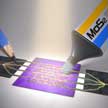 Researchers have fabricated photodetectors on paper by mimicking the action of drawing/writing with a pencil on standard paper. The results indicate that this process can be employed with other layered materials like the semiconducting molybdenum disulfide to fabricate electronic devices on paper. There are many layered materials (so called van der Waals materials) that have similar mechanical properties to graphite and thus are susceptible of being cleaved upon mechanical rubbing against paper substrates.
Researchers have fabricated photodetectors on paper by mimicking the action of drawing/writing with a pencil on standard paper. The results indicate that this process can be employed with other layered materials like the semiconducting molybdenum disulfide to fabricate electronic devices on paper. There are many layered materials (so called van der Waals materials) that have similar mechanical properties to graphite and thus are susceptible of being cleaved upon mechanical rubbing against paper substrates.
Jul 23rd, 2020
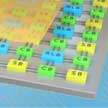 Novel complementary nanoelectromechanical (CNEM) switches based on complementary ferroelectric nanocracks integrate the advantages of ferroelectric and nanoelectromechanical switches, such as nonvolatility, quasi-zero OFF-state leakage current and low operating voltage. These ferroelectric crack-based CNEM switches could realize energy-efficient and high-density reconfigurable computing, which can be specialized to a particular task through its universal programmability, offering large flexibility and short time from design to realization.
Novel complementary nanoelectromechanical (CNEM) switches based on complementary ferroelectric nanocracks integrate the advantages of ferroelectric and nanoelectromechanical switches, such as nonvolatility, quasi-zero OFF-state leakage current and low operating voltage. These ferroelectric crack-based CNEM switches could realize energy-efficient and high-density reconfigurable computing, which can be specialized to a particular task through its universal programmability, offering large flexibility and short time from design to realization.
Jun 29th, 2020
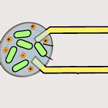 New research demonstrates the integration of synthetic biology with electronic circuitry through engineered population dynamics that regulate the accumulation of charged metabolites. The resulting sensor devices can detect changes in bacterial population in response to the presence of chemicals, light or pH. Connecting bacterial gene expression to electrodes is an appealing approach to interface genetic circuits with microelectronics for multiple applications. In this work, researchers engineered bacterial circuits capable of controlling the conductivity of the media via cell growth and death. Therefore, the electronic output is controlled by a killing gene.
New research demonstrates the integration of synthetic biology with electronic circuitry through engineered population dynamics that regulate the accumulation of charged metabolites. The resulting sensor devices can detect changes in bacterial population in response to the presence of chemicals, light or pH. Connecting bacterial gene expression to electrodes is an appealing approach to interface genetic circuits with microelectronics for multiple applications. In this work, researchers engineered bacterial circuits capable of controlling the conductivity of the media via cell growth and death. Therefore, the electronic output is controlled by a killing gene.
May 26th, 2020
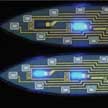 Miniaturized needle-like carriers in high aspect ratio structures are a novel class of implantable electronic devices. They are used to deliver tiny sensors and stimulation tools inside the body via minimally invasive injection or insertion into a specific area of an organ. A recent review summarizes the latest developments in materials, designs, and manufacturing techniques in the field of injectable biomedical devices, highlighting unique applications and demonstrations of viable clinical tools that were applied in various internal organs.
Miniaturized needle-like carriers in high aspect ratio structures are a novel class of implantable electronic devices. They are used to deliver tiny sensors and stimulation tools inside the body via minimally invasive injection or insertion into a specific area of an organ. A recent review summarizes the latest developments in materials, designs, and manufacturing techniques in the field of injectable biomedical devices, highlighting unique applications and demonstrations of viable clinical tools that were applied in various internal organs.
May 19th, 2020
 Researchers have developed a method to produce a wood-derived, fully bio-based, and environmentally friendly flexible electronic circuit. They tailored the wood nanostructure to create a wood film with high transparency, flexibility, and strong mechanical properties. This material compares favorably with previously published two-dimensional cellulose-based materials developed for electronics or structural applications. This flexible circuit highlights the fact that wood can be used as a feedstock, with the potential to displace petroleum-based material for high-value products.
Researchers have developed a method to produce a wood-derived, fully bio-based, and environmentally friendly flexible electronic circuit. They tailored the wood nanostructure to create a wood film with high transparency, flexibility, and strong mechanical properties. This material compares favorably with previously published two-dimensional cellulose-based materials developed for electronics or structural applications. This flexible circuit highlights the fact that wood can be used as a feedstock, with the potential to displace petroleum-based material for high-value products.
Mar 12th, 2020
 The goal of the electronics industry has always been to build durable devices with stable performance that last a very long time. 'Transient electronics', however, are designed with the exact opposite goal: to dissolve harmlessly into their surroundings after functioning for a certain amount of time. The fabrication process and the in vivo powering of medical implants that are only made from biodegradable materials are two of the challenges associated with transient electronics. Researchers demonstrate wirelessly powered, frequency-selective magnesium microstructures as promising candidates to be used as power receiver, microheaters and triggering elements for biodegradable implantable medical devices.
The goal of the electronics industry has always been to build durable devices with stable performance that last a very long time. 'Transient electronics', however, are designed with the exact opposite goal: to dissolve harmlessly into their surroundings after functioning for a certain amount of time. The fabrication process and the in vivo powering of medical implants that are only made from biodegradable materials are two of the challenges associated with transient electronics. Researchers demonstrate wirelessly powered, frequency-selective magnesium microstructures as promising candidates to be used as power receiver, microheaters and triggering elements for biodegradable implantable medical devices.
Nov 11th, 2019
 DNA is probably the most programmable biomaterial for creating a wide range of rationally designed and functionally enhanced nanostructures. The sophisticated, programmable, and addressable DNA nanostructures are strong candidates for constructing nanoelectronic devices. The size of DNA molecules is also key: DNA double-helix has a neighboring base pair distance of 0.34 nm and a diameter of 2.1 - 2.6 nm a, and thus DNA complex-based nanoelectronics may break the 5-nm processing limit of commercial silicon-based semiconductors.
DNA is probably the most programmable biomaterial for creating a wide range of rationally designed and functionally enhanced nanostructures. The sophisticated, programmable, and addressable DNA nanostructures are strong candidates for constructing nanoelectronic devices. The size of DNA molecules is also key: DNA double-helix has a neighboring base pair distance of 0.34 nm and a diameter of 2.1 - 2.6 nm a, and thus DNA complex-based nanoelectronics may break the 5-nm processing limit of commercial silicon-based semiconductors.
 Subscribe to our Nanotechnology Spotlight feed
Subscribe to our Nanotechnology Spotlight feed





